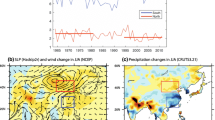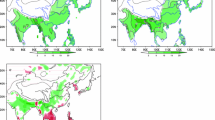Abstract
Purpose of Review
The south-flood-north-drought pattern of summer rainfall change over eastern China has been attributed to external forcing (greenhouse gas concentration and aerosol emission changes) and a coupled ocean-atmosphere mode (the Pacific Decadal Oscillation; PDO). Here, we investigate the possibility whether the north-south contrasting pattern of summer rainfall change may occur without external forcing and the PDO effect.
Recent Findings
Analysis of preindustrial and historical climate model simulations and climatological sea surface temperature–forced atmospheric model simulations identified the north-south pattern of summer rainfall changes under constant external forcing and without the PDO signal. This suggests a possible role of atmospheric internal variability. The decadal rainfall change pattern appears as a manifestation of change in the frequency of occurrence of rainfall anomaly distribution from one specific pattern to the other between two neighboring periods.
Summary
The external forcing and the ocean-atmosphere coupled mode are not necessary conditions for the occurrence of the north-south pattern of summer rainfall changes over eastern China.










Similar content being viewed by others
References
Gong D, Ho C. Shift in the summer rainfall over the Yangtze River valley in the late 1970s. Geophys Res Lett. 2002;29(10):1436. https://doi.org/10.1029/2001GL-14523.
Ding YH, Wang ZY, Sun Y. Inter-decadal variation of the summer precipitation in East China and its association with decreasing Asian summer monsoon. Part I: observed evidences. Int J Climatol. 2008;28:1139–61. https://doi.org/10.1002/joc.1615.
Wang H. The weakening of Asian monsoon circulation after the end of 1970s. Adv Atmos Sci. 2001;18:376–86. https://doi.org/10.1007/BF02919316.
Yu R, Wang B, Zhou T. Tropospheric cooling and summer monsoon weakening trend over East Asia. Geophys Res Lett. 2004;31:L22212. https://doi.org/10.1029/2004GL021270.
Menon S, Hansen J, Nazarenko L, Luo Y. Climate effects of black carbon aerosols in China and India. Science. 2002;297:2250–3.
Zhou T, Gong D, Li J, Li B. Detecting and understanding the multi-decadal variability of the East Asian summer monsoon—recent progress and state of affairs. Meteorol Z. 2009;18:455–67. https://doi.org/10.1127/0941-2948/2009/0396.
Wang T, Wang HJ, Otter OH, Gao YQ, Suo LL, Furevik T, et al. Anthropogenic agent implicated as a prime driver of shift in precipitation in eastern China in the late 1970s. Atmos Chem Phys. 2013;13(24):12433. https://doi.org/10.5194/acp-13-12433-2013.
Ye J, Li W, Li L, Zhang F. “North drying and south wetting” summer precipitation trend over China and its potential linkage with aerosol loading. Atmos Res. 2013;125–126:12–9. https://doi.org/10.1016/j.atmosres.2013.01.007.
Song F, Zhou T, Qian Y. Responses of East Asian summer monsoon to natural and anthropogenic forcings in the 17 latest CMIP5 models. Geophys Res Lett. 2014;41(2):596–603. https://doi.org/10.1002/2013GL058705.
Li X, Ting M, Li C, Henderson N. Mechanisms of Asian summer monsoon changes in response to anthropogenic forcing in CMIP5 models. J Clim. 2015;28(10):4107–25. https://doi.org/10.1175/JCLI-D-14-00559.1.
Wang HL, Xie XN, Liu XD. On the robustness of the weakening effect of anthropogenic aerosols on the East Asian summer monsoon with multimodel results. Adv Meteorol. 2015;397395. https://doi.org/10.1155/2015/397395.
Dong B, Rowan T, Highwood E, Wilcox L. Preferred response of the East Asian summer monsoon to local and non-local anthropogenic sulphur dioxide emissions. Clim Dyn. 2016;46:1733–51. https://doi.org/10.1007/s00376-012-2069-9.
Xie X, Wang H, Liu X, Li J, Wang Z, Liu Y. Distinct effects of anthropogenic aerosols on the East Asian summer monsoon between multidecadal strong and weak monsoon stages. J Geophys Res Atmos. 2016;121:7026–40. https://doi.org/10.1002/2015JD024228.
Chen H, Sun J. Anthropogenic warming has caused hot droughts more frequently in China. J Hydrol. 2017;544:306–18. https://doi.org/10.1016/j.jhydrol.2016.11.044.
Zhang L, Wu P, Zhou T. Aerosol forcing of extreme summer drought over North China. Environ Res Lett. 2017;12:034020. https://doi.org/10.1088/1748-9326/aa5fb3.
Tian F, Dong B, Robson J, Sutton R. Forced decadal changes in the east Asian summer monsoon: the roles of greenhouse gases and anthropogenic aerosols. Clim Dyn. 2018;51(9–10):3699–715. https://doi.org/10.1007/s00382-018-4105-7.
Hu ZZ. Interdecadal variability of summer climate over East Asia and its association with 500 hPa height and global sea surface temperature. J Geophys Res. 1997;102:19:403–19412. https://doi.org/10.1029/97JD01052.
Yang F, Lau K. Trend and variability of China precipitation in spring and summer: linkage to sea-surface temperatures. Int J Climatol. 2004;24:1625–44. https://doi.org/10.1002/joc.1094.
Yang XQ, Xie Q, Zhu YM, Sun XG, Guo YJ. Decadal to interdecadal variability of precipitation in North China and associated atmospheric and oceanic anomaly patterns (in Chinese). Chin J Geophys. 2005;48:789–97.
Ma Z. The interdecadal trend and shift of dry/wet over the central part of North China and their relationship to the Pacific Decadal Oscillation (PDO). Chin Sci Bull. 2007;52:2130–9. https://doi.org/10.1007/s11434-007-0284-z.
Li H, Dai A, Zhou T, Lu J. Responses of East Asian summer monsoon to historical SST and atmospheric forcing during 1950-2000. Clim Dyn. 2010;34:501–14. https://doi.org/10.1007/s00382-008-0482-7.
Zhou T, Song F, Lin R, Chen X, Chen X. The 2012 North China floods: explaining an extreme rainfall event in the context of a long-term drying tendency [in “explaining extreme events of 2012 from a climate perspective”]. Bull Amer Meteor Soc. 2013;94(9):S49–51. https://doi.org/10.1175/BAMS-D-13-00085.1.
Qian C, Zhou T. Multidecadal variability of North China aridity and its relationship to PDO during 1900–2010. J Clim. 2014;27:1210–22. https://doi.org/10.1175/JCLI-D-13-00235.1.
Zhang L, Zhou T. Drought over East Asia: a review. J Clim. 2015;28:3375–99. https://doi.org/10.1175/JCLI-D-14-00259.1.
Zhou T, Yu R, Li H, Wang B. Ocean forcing to changes in global monsoon precipitation over the recent half-century. J Clim. 2008;21:3833–52. https://doi.org/10.1175/2008JCLI2067.1.
Li X, Ting M. Understanding the Asian summer monsoon response to greenhouse warming: the relative roles of direct radiative forcing and sea surface temperature change. Clim Dyn. 2017;49(7–8):2863–80. https://doi.org/10.1007/s00382-016-3470-3.
Dong BW, Lu RY. Interdecadal enhancement of the Walker circulation over the tropical Pacific in the late 1990s. Adv Atmos Sci. 2013;30(2):247–62. https://doi.org/10.1007/s00376-012-2069-9.
Ueda H, Kamae Y, Hayasaki M, Kitoh A, Watanabe S, Miki Y, et al. Combined effects of recent Pacific cooling and Indian Ocean warming on the Asian monsoon. Nat Commun. 2015;6:8854. https://doi.org/10.1038/ncomms9854.
Zhu Y, Wang H, Ma J, Wang T, Sun J. Contribution of the phase transition of Pacific Decadal Oscillation to the late 1990s’ shift in East China summer rainfall. J Geophys Res Atmos. 2015;120:8817–27. https://doi.org/10.1002/2015JD023545.
Xu ZQ, Fan K, Wang HJ. Decadal variation of summer precipitation over China and associated atmospheric circulation after the late 1990s. J Clim. 2015;28:4086–106. https://doi.org/10.1175/JCLI-D-14-00464.1.
Bengtsson L, Hodges KI. Can an ensemble climate simulation be used to separate climate change signals from internal unforced variability? Clim Dyn. 2018;6248:1–21. https://doi.org/10.1007/s00382-018-4343-8.
Dai A, Bloecker CE. Impacts of internal variability on temperature and precipitation trends in large ensemble simulations by two climate models. Clim Dyn. 2018;365:1–18. https://doi.org/10.1007/s00382-018-4132-4.
Deser C, Phillips AS, Bourdette V, Teng H. Uncertainty in climate change projections: the role of internal variability. Clim Dyn. 2012;38:527–46. https://doi.org/10.1007/s00382-010-0977-x.
Lei Y, Hoskins B, Slingo J. Natural variability of summer rainfall over China in HadCM3. Clim Dyn. 2014;42:417–32. https://doi.org/10.1007/s00382-013-1726-8.
Schneider U, Beckers A, Finger P, Meyer-Christoffer A, Rudolf B, Ziese M. GPCC Full Data Reanalysis Version 7.0 at 0.5°: monthly land surface precipitation from rain gauges built on GTS-based and historic data. 2015. https://doi.org/10.5676/DWD_GPCC/FD_M_V7_050.
Harris I, Jones PD, Osborn TJ, Lister DH. Updated high-resolution grids of monthly climatic observations – the CRU TS3.10 Dataset. Int J Climatol. 2014;34:623–42. https://doi.org/10.1002/joc.3711.
Matsuura K, Willmott CJ. Terrestrial air temperature: 1900–2008 gridded monthly time series (version 3.01). Center for Climate Research, Dept. of Geography, University of Delaware, Newark, DE. 2009. Available online at http://www.esrl.noaa.gov/psd/data/gridded/data. UDel_AirT_Precip.html. Accessed 26 Aug 2016.
Compo GP, Whitaker JS, Sardeshmukh PD, Matsui N, Allan RJ, Yin X, et al. The Twentieth Century Reanalysis Project. Quarterly J Roy Meteorol Soc. 2011;137:1–28. https://doi.org/10.1002/qj.776.
Roxy M, Kapoor R, Terray P, Murtugudde R, Ashok K, Goswami BN. Drying of Indian sub-continent by rapid Indian Ocean warming and a weakening land-sea thermal gradient. Nat Commun. 2015;6(7423):1–10. https://doi.org/10.1038/ncomms8423.
Preethi B, Mujumdar M, Kripalani RH, Prabhu A, Krishnan R. Recent trends and tele-connections among South and East Asian summer monsoons in a warming environment. Clim Dyn. 2017;48(7–8):1–17. https://doi.org/10.1007/s00382-016-3218-0.
Rayner NA, Parker BE, Horton EB, Folland CK, Alexander LV, Rowell DP, et al. Global analyses of sea surface temperature, sea ice, and night marine air temperature since the late nineteenth century. J Geophys Res. 2003;108(D14):4407. https://doi.org/10.1029/2002JD002670.
Mantua NJ, Hare SR, Zhang Y, Wallace JM, Francis RC. A Pacific interdecadal climate oscillation with impacts on salmon production. Bull Amer Meteor Soc. 1997;78(6):1069–79. https://doi.org/10.1175/1520-0477(1997)078<1069:APICOW>2.0.CO;2.
Piao JL, Chen W, Wei K, Liu Y, Graf HF, Ahn JB, et al. Am abrupt rainfall decrease over the Asian inland plateau region around 1999 and the possible underlying mechanism. Adv Atmos Sci. 2017;34(4):45–468. https://doi.org/10.1007/s00376-016-6136-5.
Xie P, Arkin PA. Global precipitation: a 17-year monthly analysis based on gauge observations, satellite estimates, and numerical model outputs. Bull Amer Meteor Soc. 1997;78:2539–88. https://doi.org/10.1175/1520-0477(1997)078<2539:GPAYMA>2.0.CO;2.
Adler RF, Huffman GJ, Chang A, Ferraro R, Xie PP, John J, et al. The version-2 Global Precipitation Climatology Project (GPCP) monthly precipitation analysis (1979–present). J Hydrometeorol. 2003;4(6):1147–67. https://doi.org/10.1175/1525-7541(2003)004<1147:TVGPCP>2.0.CO;2.
Kanamitsu M, Ebisuzaki W, Woollen J, Yang S, Hnilo JJ, Fiorino M, et al. NCEP-DOE AMIP-II reanalysis (R-2). Bull Amer Meteor Soc. 2002;83:1631–43. https://doi.org/10.1175/BAMS-83-11-1631.
Wu R, Wen ZP, Yang S, Li YQ. An interdecadal change in southern China summer rainfall around 1992/93. J Climate. 2010;201:23(9):2389–403. https://doi.org/10.1175/2009JCLI3336.1.
Taylor KE, Stouffer RJ, Meehl GA. An overview of CMIP5 and the experiment design. Bull Amer Meteor Soc. 2012;4:485–98. https://doi.org/10.1175/BAMS-D-11-00094.1.
Schmidt GA, Kelley M, Nazarenko L, Ruedy R, Russell GL, Igor A, et al. Configuration and assessment of the GISS ModelE2 contributions to the CMIP5 archive. J Adv Model Earth Syst. 2014;6(1):141–84. https://doi.org/10.1002/2013MS000265.
Bentsen M, Bethke I, Debernard JB, Iversen T, Kirkevåg A, Seland Ø, et al. The Norwegian Earth System Model, NorESM1-M – part 1: description and basic evaluation. Geosci Model Dev Discuss. 2012;5:2843–931. https://doi.org/10.5194/gmdd-5-2843-2012.
Roeckner, E., et al. The atmospheric general circulation model ECHAM5. Part I: model description. Max Planck Institute for Meteorology Rep. 349, 127 pp. 2003. Available from MPI for Meteorology, Bundesstr. 53, 20146 Hamburg, Germany.
Eaton B. User’s guide to the Community Atmosphere Model CAM-5.1.1. NCAR, 32pp. 2012. Available online at http://www.cesm.ucar.edu/models/cesm1.0/cam/docs/ug5_1_1/ug.pdf.
Wang B, Wu R, Lau KM. Interannual variability of the Asian summer monsoon: contrasts between the Indian and western North Pacific-East Asian monsoons. J Clim. 2001;14(20):4073–90. https://doi.org/10.1175/1520-0442(2001)014<4073:IVOTAS>2.0.CO;2.
Kosaka Y, Nakamura H. Structure and dynamics of the summertime Pacific–Japan teleconnection pattern. Q J R Meteorol Soc. 2006;132:2009–30. https://doi.org/10.1256/qj.05.204.
Kosaka Y, Nakamura H. Mechanisms of meridional teleconnection observed between a summer monsoon system and a subtropical anticyclone. Part I: the Pacific–Japan pattern. J Clim. 2010;23:5085–108. https://doi.org/10.1175/2010JCLI3413.1.
Hirota N, Takahashi M. A tripolar pattern as an internal mode lf the East Asian summer monsoon. Clim Dyn. 2012;39:2219–38. https://doi.org/10.1007/s00382-012-1416-y.
Wu R, Hu ZZ, Kirtman BP. Evolution of ENSO-related rainfall anomalies in East Asia. J Clim. 2003;16(22):3742–58. https://doi.org/10.1175/1520-0442(2003)016<3742:EOERAI>2.0.CO;2.
Zhao GJ, Huang G, Wu R, Tao WC, Gong HN, Qu X, et al. A new upper-level circulation index for the East Asian summer monsoon variability. J Clim. 2015;28(24):9977–96. https://doi.org/10.1175/JCLI-D-15-0272.1.
Acknowledgements
We acknowledge the World Climate Research Programme’s Working Group on Coupled Modelling and the climate modeling groups for the CMIP5 climate model data obtained from https://pcmdi.llnl.gov/mips/cmip5/data-portal.html. The CMAP rainfall and NCEP-DOE reanalysis 2 data were obtained from ftp://ftp.cdc.noaa.gov/. The GPCP and GPCC precipitation data were obtained from https://www.esrl.noaa.gov/psd/. The CRU data were obtained from http://www.cru.uea.ac.uk/data/. The University of Delaware precipitation data were obtained from http://www.cdc.noaa.gov/. The HadISST1.1 SST data were obtained from https://climatedataguide.ucar.edu/climate-data/sst-data-hadisst-v11/. The twentieth century reanalysis data were acquired via https://www.esrl.noaa.gov/psd/data/20thC_Rean/.
Funding
This study is supported by the National Natural Science Foundation of China grants 41530425, 41775080, and 41721004.
Author information
Authors and Affiliations
Corresponding author
Ethics declarations
Conflict of Interest
The authors declare that they have no conflict of interest.
Additional information
Publisher’s Note
Springer Nature remains neutral with regard to jurisdictional claims in published maps and institutional affiliations.
This article is part of the Topical Collection on Monsoons and Climate
Rights and permissions
About this article
Cite this article
Wu, R., You, T. & Hu, K. What Formed the North-South Contrasting Pattern of Summer Rainfall Changes over Eastern China?. Curr Clim Change Rep 5, 47–62 (2019). https://doi.org/10.1007/s40641-019-00124-z
Published:
Issue Date:
DOI: https://doi.org/10.1007/s40641-019-00124-z




